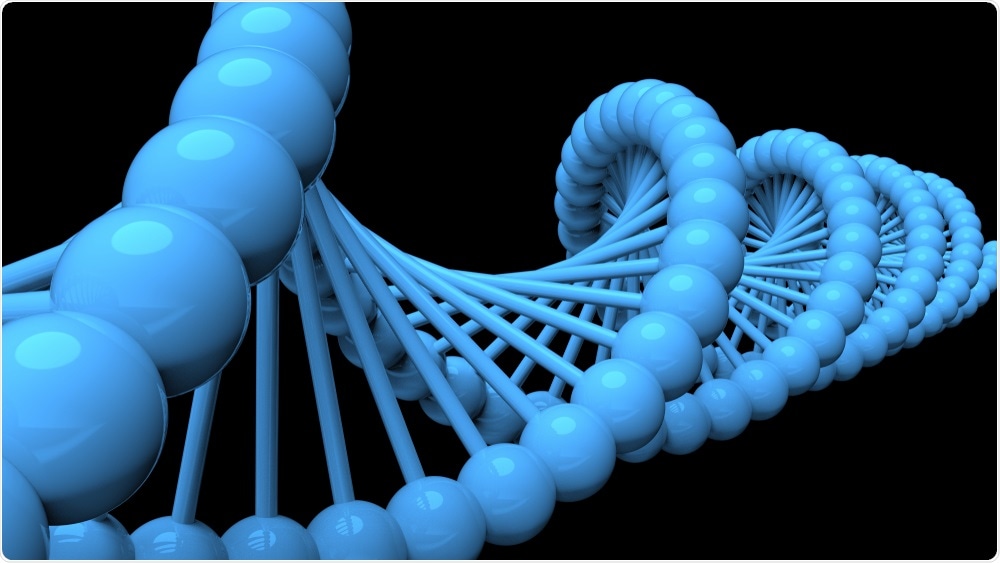Researchers at Chalmers University of Technology in Sweden have made an important discovery about DNA that could completely change how scientists understand medicine and the life sciences.
 DRN Studio | Shutterstock
DRN Studio | Shutterstock
DNA is made up of two strands of sugar molecules and phosphate groups, with nitrogen bases in between them that are held together by hydrogen bonds. Until now, the understanding had been that it is those hydrogen bonds that hold the two DNA strands together.
Now, Feng and colleagues’ study suggests that the molecules have a hydrophobic interior in what is an environment mainly consisting of water and that this is what is responsible for DNA’s helical structure.
The environment is therefore hydrophilic, while the nitrogen bases are hydrophobic and push away any surrounding water. When the hydrophobic bases are in a hydrophilic environment, they gather together to avoid being exposed to water.
The hydrogen bonds had previously been thought of as essential to holding the DNA strands together, but their role appears to be more related to organizing the base pairs so that they are bound together in the correct sequence.
The team write:
The main stabilizer of the DNA double helix is not the base-pair hydrogen bonds but coin-pile stacking of base pairs, whose hydrophobic cohesion, requiring abundant water, indirectly makes the DNA interior dry so that hydrogen bonds can exert full recognition power."
The discovery is crucial
This important discovery will be crucial to understanding how the relationship between DNA and its environment.
"Cells want to protect their DNA, and not expose it to hydrophobic environments, which can sometimes contain harmful molecules," says Feng…"But at the same time, the cells' DNA needs to open up in order to be used."
"We believe that the cell keeps its DNA in a water solution most of the time, but as soon as a cell wants to do something with its DNA, like read, copy or repair it, it exposes the DNA to a hydrophobic environment."
For instance, during reproduction, the base pairs separate from one another and open up so that enzymes can then copy each side of the helix to form a new strand of DNA. When damaged DNA needs to be repaired, the damaged are parts are exposed to a hydrophobic environment so that they can be replaced.
The hydrophobic environment is created by a catalytic protein that is central to all DNA repairs, meaning this type of protein could be crucial in combatting many serious illnesses.
Understanding how DNA repair is linked to bacterial survival and cancer
Understanding this protein could help researchers understand how to fight resistant bacteria, for example, and could even potentially lead to a cure for cancer.
To repair their DNA, bacteria use a protein called RecA, and Feng and team think their findings could shed light on how this process works and potentially lead to ways of stopping the repair so that the bacteria die.
In humans, mutated DNA sequences are repaired by the protein Rad51, and without this repair, cancer could develop.
To understand cancer, we need to understand how DNA repairs. To understand that, we first need to understand DNA itself. So far, we have not, because we believed that hydrogen bonds were what held it together.
Now, we have shown that instead, it is the hydrophobic forces which lie behind it. We have also shown that DNA behaves totally differently in a hydrophobic environment. This could help us to understand DNA, and how it repairs.
Nobody has previously placed DNA in a hydrophobic environment like this and studied how it behaves, so it's not surprising that nobody has discovered this until now."
Bobo Feng, First Author
Understanding how DNA enzymes work
The researchers are the first to study how DNA behaves in an environment that is more hydrophobic than usual. Using a solution called polyethylene glycol, they gradually changed the DNA's surroundings from a hydrophilic environment to a hydrophobic one.
The aim was to find out whether there is a point where DNA begins to lose its structure once it no longer has a reason to bind because it is no longer in a hydrophilic environment.
The team found that once the solution reached the borderline between hydrophilic and hydrophobic, the DNA started to lose its characteristic helical shape.
On taking a closer look, the researchers saw that when the base pairs separated from one another, holes develop in the structure, which allowed water to leak in. Since DNA needs to keep its interior dry, it presses together, with base pairs gathering together to push the water out.
In a hydrophobic environment, the water is missing, meaning the holes stay where they are.
“We speculate that hydrophobic catalysis is a general phenomenon in DNA enzymes,” concludes the team.
Journal reference:
Feng, B., et al. (2019). Hydrophobic catalysis and a potential biological role of DNA unstacking induced by environment effects. PNAS. https://www.pnas.org/content/116/35/17169.short?rss=1